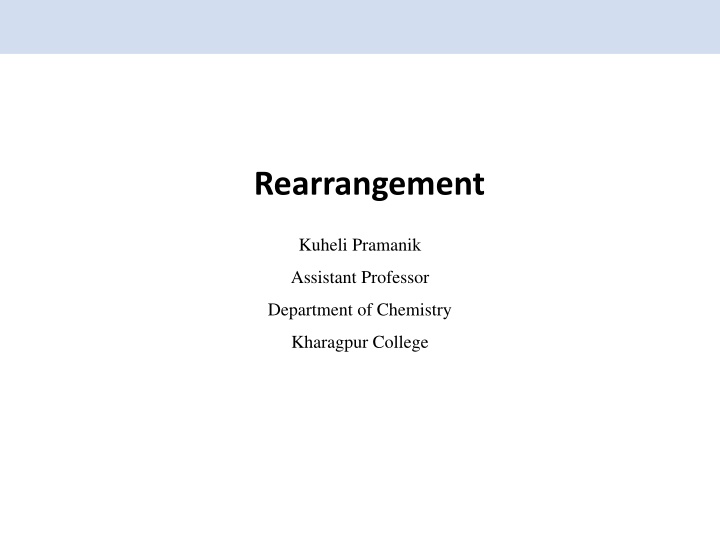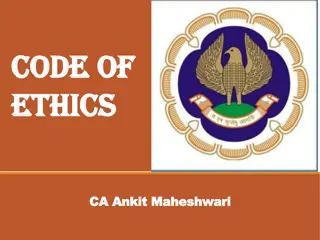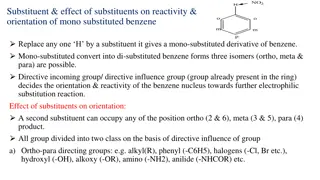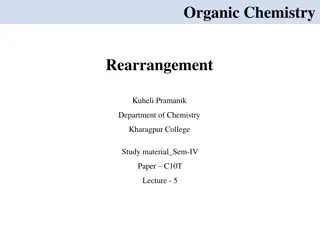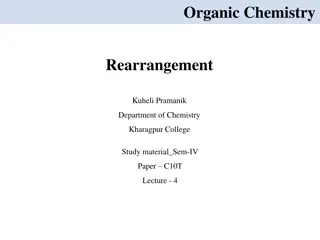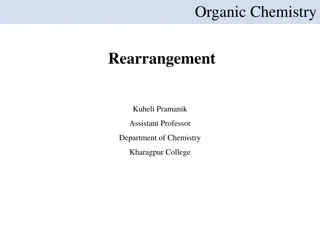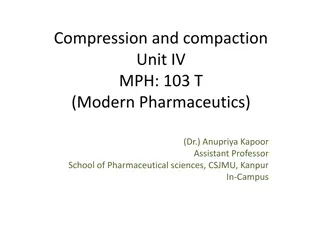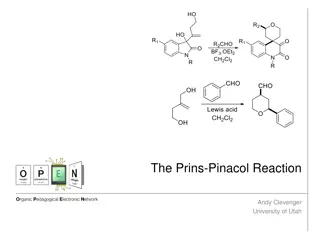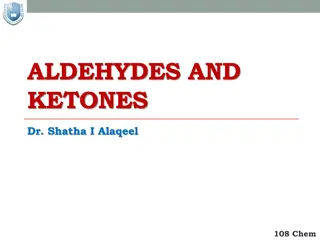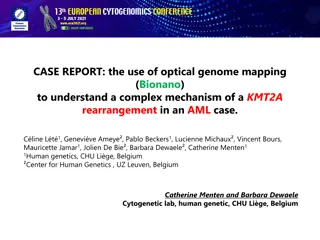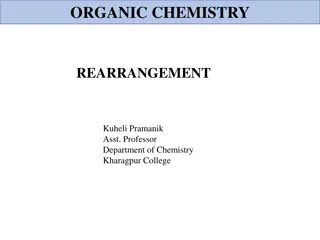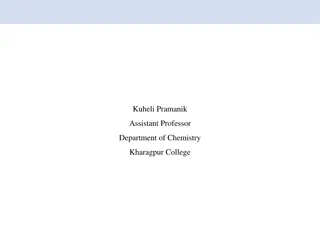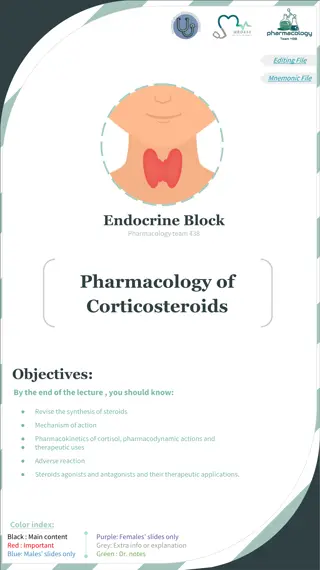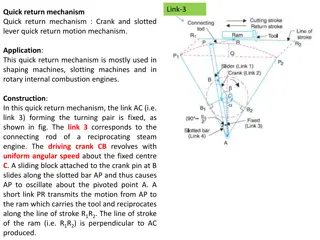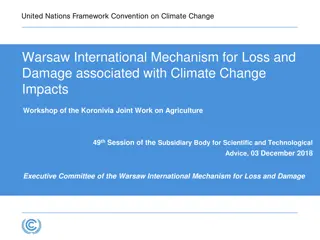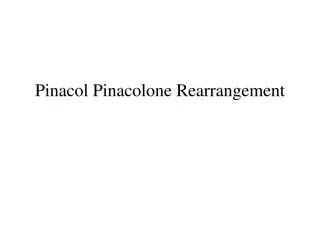Benzidine Rearrangement: Mechanism and Substituent Effects
Benzidine rearrangement involves the conversion of hydrazobenzenes into a mixture of benzidine and diphenylene under acidic conditions. Various substituents influence the product formation, with o-/m- positions favoring benzidines, and p- positions leading to different products based on the nature of the substituents. The mechanism of the rearrangement is intramolecular and has been studied through crossover experiments. The rearrangement follows a third-order reaction and proceeds via an intermediate containing two protons. Claisen rearrangement is also discussed, highlighting the migration of the allyl group under specific conditions.
Download Presentation

Please find below an Image/Link to download the presentation.
The content on the website is provided AS IS for your information and personal use only. It may not be sold, licensed, or shared on other websites without obtaining consent from the author.If you encounter any issues during the download, it is possible that the publisher has removed the file from their server.
You are allowed to download the files provided on this website for personal or commercial use, subject to the condition that they are used lawfully. All files are the property of their respective owners.
The content on the website is provided AS IS for your information and personal use only. It may not be sold, licensed, or shared on other websites without obtaining consent from the author.
E N D
Presentation Transcript
Rearrangement Kuheli Pramanik Assistant Professor Department of Chemistry Kharagpur College
Benzidine semidine Rearrangement When hydrazobenzene is treated with acids (ethanolic HCl), it is converted into a mixture of benzidine (~75%) and diphenylene (~25%) Study with wide variety of substituted hydrazobenzenes disclosed the formation of variety of products. Aniline and azobenzene may also form by disproportionation. 2PhNH-NHPh 2PhNH2 + Ph-N=N-Ph For example, p,p -PhC6H4NH-NHC6H4Ph gives 88% disproportionation products at 25 oC.
Substituent effect Hydrazoarenes containing substituents at o-/m- positions give benzidines as major product on rearrangement while containing one or two substituents at p- position give side products. a) If the p- position of one of the nucleus contains a +R group like OMe, -Oet, the o-semidine type compound is the major product along with small amount of p-semidine. b) If the p- position of one of the nucleus contains a I group, a diphenylene type compound and the o- semidine type compound is formed. c) If both p-positions are blocked, the major product is o-semidine type compound. d) When p-position (one or both) is blocked by carboxyl or sulfonic acid group, the group gets ejected and benzidine is formed
Mechanism The rearrangement is intramolecular and has been proved by crossover experiments. For example 2,2-dimethoxyhydrazobenzene and 2,2-diethoxyhydrazobenzene gives corresponding 3,3-dimethoxybenzidine and 3,3-diethoxybenzidine. NO cross-products was observed. Hammond and Shine have shown that the benzidine and semidine rearrangement follows a 3rd order reaction, i.e.- Rate = k[substrate].[H+]2 Therefore it is clear that the rearrangement proceeds via an intermediate which contains two protons. Hammond et al. showed that p,p -dideuterio hydrazobenzene rearrange at the same rate as that of hydrazobenzene. It therefore appears that the breaking of C-H bonds occurs after and not during the rate determining step.
Mechanism From the evidences the mechanism of the rearrangement can be drawn as follows:
Claisen rearrangement The rearrangement of allyl aryl ether allyl phenol is known as Claisen rearrangement. This reaction proceeds under heating and without any catalyst. The allyl group migrates to one of the ortho-positions if free. If both the ortho-positions are occupied, then only the migration happens to para-position. The Claisen rearrangement is an exothermic reaction. There are substantial solvent effects observed in the Claisen rearrangement, where polar solvents tend to accelerate the reaction to a greater extent. Hydrogen-bonding solvents gave the highest rate constants. For example, ethanol/water solvent mixtures give rate constants 10-fold higher than sulfolane. This rearrangement is a concerted (bond cleavage and recombination) pericyclic reaction. Woodward Hoffmann rules show a suprafacial, stereospecific reaction pathway.
Mechanism Heating a mixture of two different allyl aryl ethers (1 and 2) together doesn t give any cross product (5, 6). Therefore, it follows an intramolecular reaction pathway. This is further supported by first order reaction kinetics. Cross products In the intramolecular process, the reaction proceeds through a cyclic T.S. where new C-C bond forms and at the same time old C-O bond cleaves. Thus for ortho migration
Mechanism When the ortho positions are blocked, the first step is still the ortho migration leading to a cyclohexadieneone (I). Lacking a H atom at the ortho position, prevents the aromatization of 1 and hence it undergo a further rearrangement by allyl group migration via a deformed six member T.S. (II), which finally aromatizes to give a para-substituted allyl phenol. Experimental evidences 1. The intermediate cyclohexadieneone (I) is trapped by Diels-Alder reaction. 2. When an allyl ether labeled with 14C atom ( carbon) is subjected to Claisen rearrangement, it is found that the carbon atom forms bond in the ortho-position whereas the carbon atom forms the bond in the para-position.
3. It was further demonstrated that when 14C labeled allyl-2,6-diallyl phenyl ether (III) was subjected to Claisen rearrangement, the labelled 14C atom was equally distributed to ortho- and para-rearranged products (IV & V). 4. When the substrate VI containing 14C labelled allyl group is subjected to Claisen rearrangement and and the product is degraded, we get formaldehyde which does not show radioactivity, but the other product of degradation (VII) retains total activity. If the carbon instead of 14C were migrated, the degraded formaldehyde would have been radioactive. Thus the above experiments shows that the carbon atom migrates in the Claisen rearrangement.
Examples Out of Claisen rearrangement Explain which product will form and why? 5) Product 1 is formed through T.S.-1 and product 2 is formed through T.S.-2. The T.S.-2 is energetically less favorable as in this case no ring is aromatic and hence less stable.
Examples 6) 7) The isotope is equally distributed between the terminal methylene groups in the para- product 8) In this example the stereocenter at C-1 is completely transferred to newly generated stereocenter at C-3. During the migration of the -bond, it remains on the same side of the cyclohexane ring. This type of stereocontrolloed transformation of a stereocenter into a new one is termed as chirality transfer and in this case, it is a 1,3-chirality transfer.
IrelandClaisen rearrangement The Ireland Claisen rearrangement is the reaction of an allylic carboxylate with a strong base (such as lithium diisopropylamide) to give a , -unsaturated carboxylic acid. The rearrangement proceeds via silylketene acetal, which is formed by trapping the lithium enolate with chlorotrimethylsilane. Ireland-Claisen rearrangement can take place at room temperature and above. The E- and Z-configured silylketene acetals lead to anti and syn rearranged products, respectively.
AzaClaisen (or amino Claisen) This is actually a nitrogen analogue of simple Claisen rearrangement. An iminium can serve as one of the pi-bonded moieties in the rearrangement. Overman rearrangement The Overman rearrangement is a Claisen rearrangement of allylic trichloroacetimidates to allylic trichloroacetamides.
Claisen-Cope rearrangement Claisen rearrangement is also given by allyl vinyl ether and in this case the rearrangement is known as aliphatic Claisen rearrangement or Claisen-Cope rearrangement. The reaction proceeds preferably via a chair transition state. Chiral, enantio-pure starting materials give high enantio-pure product. A boat transition state is also possible, and can lead to side products:
